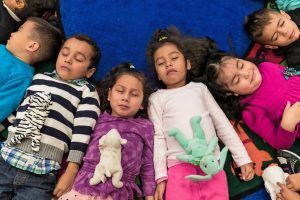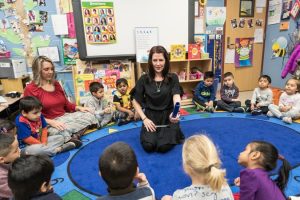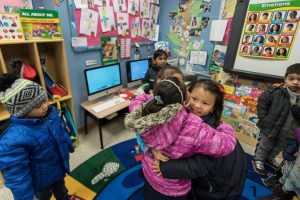Source: THE NEW YORK TIMES
By RICHARD SCHIFFMANDEC. 14, 2017

Prekindergarten students at P.S. 212 in Jackson Heights, Queens, observe their “belly buddies” — stuffed animals placed on their stomachs — as they rise and fall with their breath. The lesson is part of the Kindness Curriculum. Credit Jeenah Moon for The New York Times
Thanks to a challenge from the Dalai Lama, a number of preschools are trying to teach something that has not always been considered an academic subject: kindness.
“Can you look inside yourself and tell me what you’re feeling?” Danielle Mahoney-Kertes asked a class of prekindergarten students at P.S. 212 in Queens recently.
“Happy,” one girl offered. “Sick,” said another. A boy in a blue T-shirt gave a shy thumbs down. “That happens too,” Ms. Mahoney-Kertes, a literacy coach, reassured him.
The exercise was part of the Kindness Curriculum, developed by the Center for Healthy Minds at the University of Wisconsin, Madison, in which preschoolers are introduced to a potpourri of sensory games, songs and stories that are designed to help them pay closer attention to their emotions.
“Our world is kind of a scary place,” Ms. Mahoney-Kertes said. “We can’t always control what is happening outside us. But what we’re teaching them is that they can control how they respond.”
Since the curriculum was introduced in August, more than 15,000 educators, parents and others from around the world have signed up for it.
P.S. 212, which is in a neighborhood in Jackson Heights that is home to many new immigrants, was one of the first public schools in New York City to introduce mindfulness-based practices like yoga. The Kindness Curriculum, which incorporates mindfulness, was a natural fit.
“A child can come in and say, ‘My father was deported last night.’ How do you deal with that?” said the school’s principal, Carin Ellis. “We give them tools to cope with their hurt and pain.”
Ms. Ellis believes the Kindness Curriculum has also helped kids manage the stress of standardized testing and cut down on interpersonal conflicts.

Danielle Mahoney-Kertes leads students at P.S. 212 in an exercise in mindful listening. The school was one of the first public schools in New York City to introduce mindfulness-based practices including the Kindness Curriculum. Credit Jeenah Moon for The New York Times
“When you’re unkind to another, it’s usually about ourselves and how we are feeling,” she said. “If children can take a moment and just breathe, they can avoid acting out against others.”
There appear to be other benefits. Research led by the clinical psychologist Lisa Flook has shown that youngsters who received the kindness training become more altruistic in tests that measured their willingness to share with others. It also strengthened children’s ability to focus and modestly boosted their academic performance.
Some argue that emotional skills are better taught by parents than by teachers. But Dr. Flook points out that when kids come to the classroom anxious, angry or fearful, they are often too distracted to focus. “Children who have positive relationships with their peers and teachers do better in school,” she said.
They may also fare better later in life. One 2015 study that tracked kindergartners to young adulthood found that individuals with good prosocial skills — behavior that is positive, helpful and friendly — tended to be more successful as adults than those who did well in subjects like reading and math but lacked the ability to get along with others.
The Kindness Curriculum is part of a growing global movement to teach emotional intelligence in schools. Advocates of this approach say it’s shortsighted for teachers to focus narrowly on intellectual learning and ignore the cooperative emotional skills that enable learning — and learners — to flourish.
Still, some question whether personality traits like kindness can be taught.
Richard Davidson, the founder of the Center for Healthy Minds, believes that ancient Buddhist wisdom provides clues. He was inspired, he said, by a request from Tibet’s spiritual leader, the Dalai Lama, who asked him to take insights from contemplative practice out of their religious context and use them to develop strategies to help improve people’s lives.
Buddhist meditators observe their bodily sensations and feelings to create a sense of calm that is meant to foster compassion. Dr. Davidson said he used that concept as the basis for teaching children to watch how their bodies move and feel.
In one practice, children observe their “belly buddy,” a stuffed animal placed on their stomachs, as it rises and falls with their breath. Belly breathing has been adapted by the children’s program “Sesame Street,” which consulted with the University of Wisconsin team and made kindness the theme of its latest season.
The program encourages children “to identify their feelings and to put a label to them,” said Rosemarie Truglio, senior vice president of curriculum and content at Sesame Workshop, which produces “Sesame Street.”

“Children who have positive relationships with their peers and teachers do better in school,” said Lisa Flook, a psychologist who has studied efforts to teach kindness. Credit Jeenah Moon for The New York Times
“When you help a child do that, they feel validated — it helps them to understand that feeling.”
Dr. Truglio observed that the more aware children are of their own emotions, the better they are able to empathize with the feelings of others and to respond to them in a helpful manner. Initially, many of the children they worked with didn’t know what the word “kind” meant, she recalls. Parents and teachers were always telling them to be “nice.” “We wanted to give them the word ‘kind,’” she said, “but to define it not so much in words as through behaviors.”
On “Sesame Street,” the characters model a variety of kind actions. For example, Big Bird’s friends help him conquer his stage fright; Elmo patiently waits as Zoe learns to use his scooter. The program then cuts to its “kindness cam,” which shows real children engaging in similar behaviors.
Sesame Street’s own research prompted its focus on kindness. In a national survey of 2,502 parents and teachers, over three-quarters said that they often worried that “the world is an unkind place for children.” Roughly the same percentage said that it was more important for children to learn kindness than to get good grades.
Dr. Davidson said that the period between ages 4 and 7 is a critical developmental window when the brain is reorganizing and particularly open to learning new information (like foreign languages) as well as developing lifelong psychological habits.
In order to have a lasting impact, he said, the emotional lessons taught to preschoolers need to be reinforced as the kids grow older.
One program working on kindness with older students, the Los Angeles-based “Kind Campaign,” founded in 2009, organizes middle and high school assemblies that target the problem of bullying between young women. The girls are invited to write a “kind apology” and hand it to somebody who they have wronged.
Another group, the Random Acts of Kindness Foundation, has developed lesson plans for all age groups through high school. Students are guided in classroom discussions and asked to come up with positive actions, like sitting with someone who is alone in the lunchroom and writing imaginative thank you letters to their future selves.
“Kindness to oneself is a key,” said Brooke Jones, the foundation’s vice president. “When let’s say you fail a test, do you say to yourself ‘I’m stupid,’ or do you say to yourself, ‘I have more to learn?’ We focus on the importance of kids believing in themselves.”
Ms. Mahoney-Kertes points out, however, that, educators must practice what they preach for their lessons to be truly effective. “Teachers need to work on themselves. They need to become examples of the kindness that they are trying to teach.”




 Print
Print Email
Email